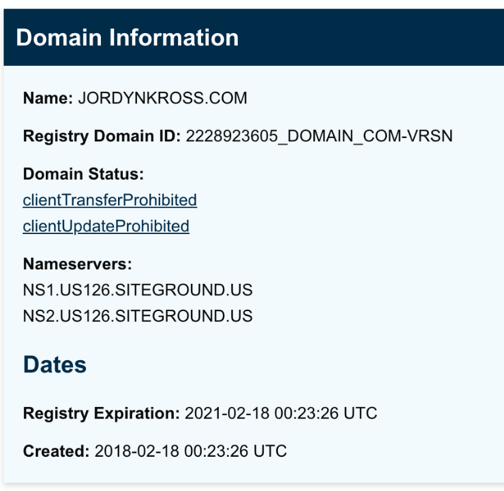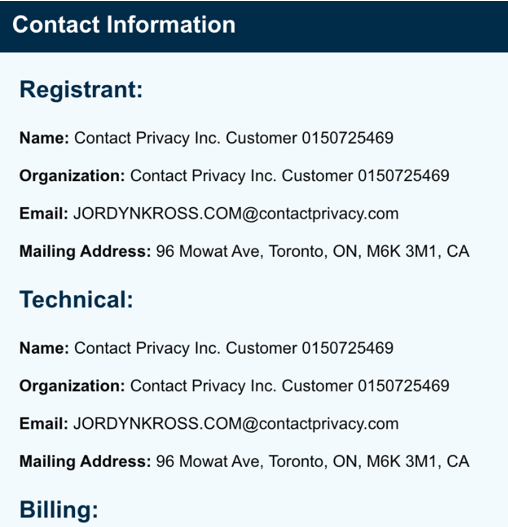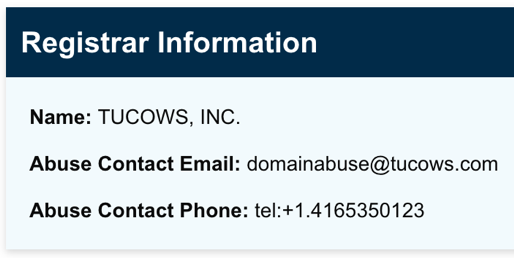WHOIS Lookup
Every website on the internet has a domain name. If you have a website, you’re probably familiar with the process of registering your domain (author.com) and renewing that registration periodically.
When you register that name, you provide ownership information to ICANN. ICANN is the not-for-profit organization that coordinates the naming system used to navigate the internet. For example, they decide if .biz is valid. For an old school analogy, your domain is a phone number and ICANN hosts the yellow pages.
But ICANN doesn’t print a directory and mail it out to all the people with domains. Actually, neither does Yellow Pages anymore. Instead, they have a website where you can look up who owns a particular domain: https://lookup.icann.org/.
When you enter in a domain (e.g., JordynKross.com), the lookup will return a page of information. The first three sections are interesting.
Section 1: Domain Information
 The first section is Domain Information. (Figure 1, left. Domain information returned from a 'JordynKross.com' search on lookup.ICANN.org.) The first section is Domain Information. (Figure 1, left. Domain information returned from a 'JordynKross.com' search on lookup.ICANN.org.)
This data confirms the domain you looked up. It has the registry record identification number, the domain status, and then the most interesting piece of data for this section: Nameservers. These are the servers that know where jordynkross.com is located. Going back to our phonebook analogy, these servers have the address for the domain. And usually, these servers are named for the company that is hosting the domain website.
This is important. Because if the site you’re researching has an illegal copy of your book and has ignored your DMCA takedown request, this is where you’re going to go next.
Section 2: Contact Information
 The next section of information in the lookup is Contact Information. (Figure 2, left. Contact information from search.) The next section of information in the lookup is Contact Information. (Figure 2, left. Contact information from search.)
There are four categories in this area: Registrant, Technical, Billing, and Admin. In some cases, there will be direct contact information in this area. More often it will be either “redacted” or list a privacy agency. This is like the old “unlisted” phone numbers and has the same purpose—to reduce unwanted solicitations.
The Technical contact or Admin contact email can be used to file a complaint with the host. Most likely the email on the website itself will be just as useful. And you’ve likely already filed a takedown request with the domain directly and are now moving to the next steps in the process.
Section 3: Registrar Information
 Which brings to the third piece of interesting information in this report: Registrar Information. (Figure 3, left. Registrar information from search.) Which brings to the third piece of interesting information in this report: Registrar Information. (Figure 3, left. Registrar information from search.)
Notice the email address is labeled Abuse. This is a great place to file an additional takedown request.
The host domain is a first level lookup. In cases where you’re investigating a pirate site, it’s likely that there will be many layers of registrations. You can continue to trace the site and identify potential companies that may comply with the takedown notice by doing lookups on the information you found.
For example, you could do a lookup on Siteground.com (the host) or TuCows.com (the registrar).
You can continue down the rabbit hole past two or three levels of searches, but the further you go from the original domain lookup the less likely you are to get a response. Use the data closest to your original search to file complaints and then follow up with the hosting and registration sites if there is no response.
|

 The first section is Domain Information. (Figure 1, left. Domain information returned from a 'JordynKross.com' search on lookup.ICANN.org.)
The first section is Domain Information. (Figure 1, left. Domain information returned from a 'JordynKross.com' search on lookup.ICANN.org.) The next section of information in the lookup is Contact Information. (Figure 2, left. Contact information from search.)
The next section of information in the lookup is Contact Information. (Figure 2, left. Contact information from search.) Which brings to the third piece of interesting information in this report: Registrar Information. (Figure 3, left. Registrar information from search.)
Which brings to the third piece of interesting information in this report: Registrar Information. (Figure 3, left. Registrar information from search.)